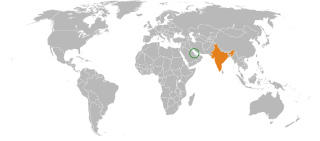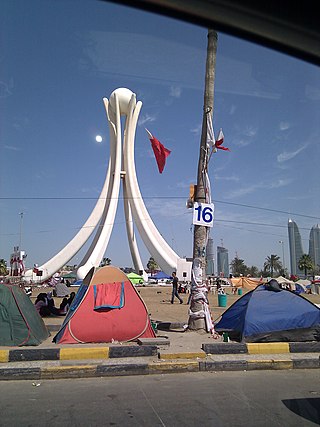Contents
| |||||
| Decades: | |||||
|---|---|---|---|---|---|
| See also: | |||||
Events in the year 2024 in Bahrain.
| |||||
| Decades: | |||||
|---|---|---|---|---|---|
| See also: | |||||
Events in the year 2024 in Bahrain.
| Photo | Post | Name |
|---|---|---|
 | King of Bahrain | Hamad bin Isa Al Khalifa |
 | Prime Minister of Bahrain | Salman bin Hamad bin Isa Al Khalifa |
Source: [4]

Eid al-Fitr is the earlier of the two official holidays celebrated within Islam. Eid al-Fitr is celebrated by Muslims worldwide because it marks the end of the month-long dawn-to-dusk fasting of Ramadan. Eid al-Fitr falls on the first day of Shawwal in the Islamic calendar; this does not always fall on the same Gregorian day, as the start of any lunar Hijri month varies based on when the new moon is sighted by local religious authorities. The holiday is known under various other names in different languages and countries around the world. The day is also called Eid I or "Lesser Eid", or simply Eid.

In the United States, public holidays are set by federal, state, and local governments and are often observed by closing government offices or giving government employees paid time off. The federal government does not require private businesses to close or offer paid time off, as is the case for most state and local governments, so employers determine which holidays to observe.

The Bahrain national football team represents Bahrain in international football and is controlled by the Bahrain Football Association, which was founded in 1951 and joined FIFA in 1966. They have never reached the World Cup, but have twice come within one match of doing so. Bahrain won the FIFA's most improved team award in 2004, and finished fourth in the 2004 Asian Cup, beating Uzbekistan in the quarter-finals but losing to Japan in the semi-finals 4–3. Bahrain then lost to Iran in the third-place match, thus finishing in fourth place overall. Bahrain had a golden year in 2019, winning both the WAFF Championship and the Arabian Gulf Cup for the first time, under the stewardship of Hélio Sousa.

Al-Ahli Club of Manama is a Bahraini sports club based in the capital city of Manama. Their men's football section plays in the Bahraini Premier League, the top division of domestic football competitions. The club also fields players in other sports such as basketball, handball and volleyball. Their home stadium is Al Ahli Stadium, although like all other teams in Bahrain they mainly play at Bahrain National Stadium.

Al-Najma SC is a Bahraini professional multi-sports club based in Manama. Incorporated in 1946, the club has departments of football, handball, volleyball and basketball. The club's football section competes in the Bahraini Premier League, the top-flight of Bahraini football.

Bahrain, officially the Kingdom of Bahrain, is an island country in West Asia. It is situated on the Persian Gulf, and comprises a small archipelago made up of 50 natural islands and an additional 33 artificial islands, centered on Bahrain Island which makes up around 83 percent of the country's landmass. Bahrain is situated between Qatar and the northeastern coast of Saudi Arabia, to which it is connected by the King Fahd Causeway. The population of Bahrain is 1,501,635 as of May 14, 2023, based on elaborations of the United Nations data, of whom 712,362 are Bahraini nationals. Bahrain spans some 760 square kilometres (290 sq mi), and is the third-smallest nation in Asia after the Maldives and Singapore. The capital and largest city is Manama.

Political, socio-economic, military and cultural ties exist between India and Bahrain. India is a close ally of Bahrain. As per Indian officials, the Kingdom along with its GCC partners are amongst the world's most prominent supporters of India's candidacy for a permanent seat on the UN Security Council, and Bahraini officials have urged India to play a greater role in international affairs. For instance, over concerns about Iran's nuclear programme, Bahrain's Crown Prince requested India to play an active role in resolving the crisis.

Sanabes is one of the villages in Tarut Island, the second biggest island that is located on the east coast Saudi Arabia in the Persian Gulf. Sanabes extends on Tarut beach for about four kilometers which starts from what used to be called the Elementary School of Ammar ibn Yasir and now Middle school of Sanabes until Al-Saffar Farm, bounded by Al Rabai’yah southwest and by Tarut village to the west, Al-Zoor to the north and Darain to the south. The location has two advantages: The fertile soil and excellent fishing places. There is also a village called Sanabes in neighbouring Bahrain, a few miles from the capital, Manama. Like the Saudi Sanabes, the Bahraini village of Sanabes is also populated by Shi'a Muslims.

The 2011Bahraini uprising was a series of anti-government protests in Bahrain led by the Shia-dominant and some Sunni minority Bahraini opposition from 2011 until 2014. The protests were inspired by the unrest of the 2011 Arab Spring and protests in Tunisia and Egypt and escalated to daily clashes after the Bahraini government repressed the revolt with the support of the Gulf Cooperation Council and Peninsula Shield Force. The Bahraini protests were a series of demonstrations, amounting to a sustained campaign of non-violent civil disobedience and some violent resistance in the Persian Gulf country of Bahrain. As part of the revolutionary wave of protests in the Middle East and North Africa following the self-immolation of Mohamed Bouazizi in Tunisia, the Bahraini protests were initially aimed at achieving greater political freedom and equality for the 70% Shia population.

The GCC Roundabout, known as Pearl Roundabout or Lulu Roundabout (Arabic: دوار اللؤلؤ Dawwār al-luʾluʾ , "Roundabout of the pearl " was a roundabout located near the financial district of Manama, Bahrain. The roundabout was named after the pearl monument that previously stood on the site and was destroyed on 18 March 2011 by government forces as part of a crackdown on protesters during the Bahraini uprising of 2011.
The following is an incomplete timeline of events that followed the Bahraini uprising of 2011 from July to December 2011. This phase saw many popular protests, escalation in violence and the establishment of an independent government commission to look into the previous events.

The following is a timeline of the Bahraini uprising from February to March 2011, beginning with the start of protests in February 2011 and including the Saudi and Emirati-backed crackdown from 15 March.
The following is an incomplete timeline of events that followed the Bahraini uprising of 2011 from January to August 2012. This phase saw the first anniversary protest of the Bahraini uprising, the largest demonstrations in the history, and the escalation of violent clashes between youths and security forces.

The Day of Rage is the name given by protesters in Bahrain to 14 February 2011, the first day of the national uprising as part of the Arab Spring. Inspired by successful uprisings in Egypt and in Tunisia, Bahraini youth organised protests using social-media websites. They appealed to the Bahraini people "to take to the streets on Monday 14 February in a peaceful and orderly manner". The day had a symbolic value, being the ninth and tenth anniversaries of the country's 2002 constitution and the National Action Charter respectively.

The March of loyalty to martyrs was a protest on 22 February 2011 in Manama, Bahrain. Tens of thousands participated in the protest, one of the largest in the Bahraini uprising. Named after the seven victims killed by police and army forces during previous protests, the march filled the space between Bahrain mall and Pearl Roundabout. Protesters carried Bahrain's flag and demanded the fall of the government, implementation of a constitutional monarchy and other reforms, with some of them also demanding the end of the regime.

Abdulredha Mohamed Hasan Buhmaid was a 28-year-old Bahraini protester shot by a live bullet in the head on 18 February 2011. He died in hospital three days later, the seventh death in the Bahraini uprising.
The following is an incomplete timeline of events that followed the Bahraini uprising of 2011 from September 2012 onward.
Bahrain Tamarod, also known as August 14 Rebellion, was a three-day protest campaign in Bahrain that began on 14 August 2013, the forty-second anniversary of Bahrain Independence Day and the two-and-a-half-year anniversary of the Bahraini uprising. The call for protests had started in early July following and inspired by the Egyptian Tamarod Movement that led to the removal of President Mohamed Morsi. Calling for a "free and democratic Bahrain", Tamarod activists, who mobilized social networking websites, said their movement was peaceful, national and non-sectarian. They called for gradual peaceful civil disobedience starting from 14 August. The movement gained the support of opposition societies and human rights activists, including those languishing in prison. The government however, repeatedly warned against the protests, promising those who participate with legal action and forceful confrontation. Rights activists and media reported that authorities had stepped up their crackdown campaigns in the weeks leading to the protests.
Events in the year 2023 in Bahrain.
Events in the year 2024 in Morocco.